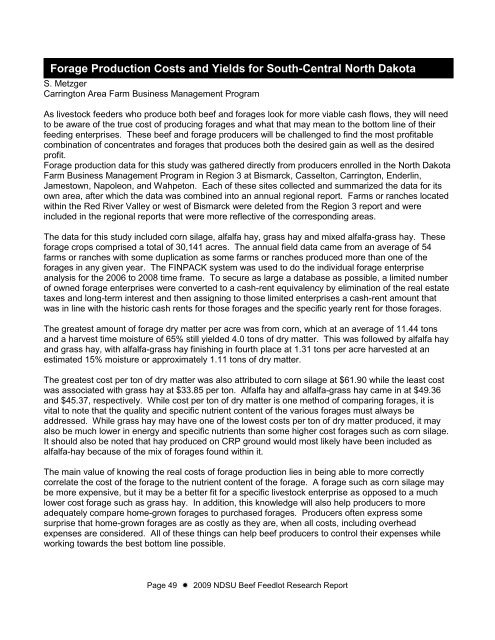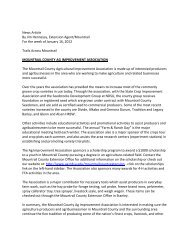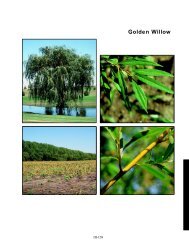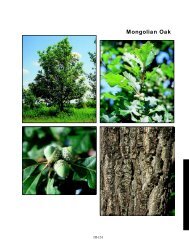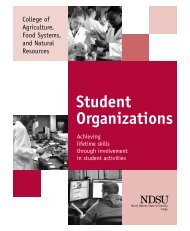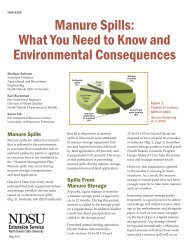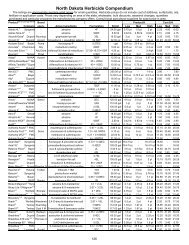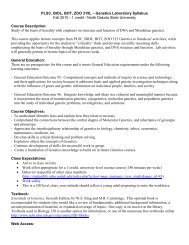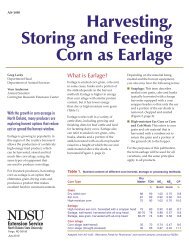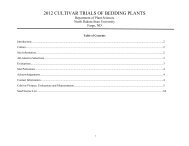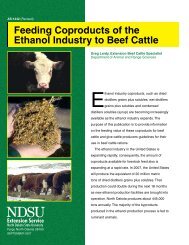NDSU Beef Feedlot - NDSU Agriculture - North Dakota State ...
NDSU Beef Feedlot - NDSU Agriculture - North Dakota State ...
NDSU Beef Feedlot - NDSU Agriculture - North Dakota State ...
Create successful ePaper yourself
Turn your PDF publications into a flip-book with our unique Google optimized e-Paper software.
Forage Production Costs and Yields for South-Central <strong>North</strong> <strong>Dakota</strong><br />
S. Metzger<br />
Carrington Area Farm Business Management Program<br />
As livestock feeders who produce both beef and forages look for more viable cash flows, they will need<br />
to be aware of the true cost of producing forages and what that may mean to the bottom line of their<br />
feeding enterprises. These beef and forage producers will be challenged to find the most profitable<br />
combination of concentrates and forages that produces both the desired gain as well as the desired<br />
profit.<br />
Forage production data for this study was gathered directly from producers enrolled in the <strong>North</strong> <strong>Dakota</strong><br />
Farm Business Management Program in Region 3 at Bismarck, Casselton, Carrington, Enderlin,<br />
Jamestown, Napoleon, and Wahpeton. Each of these sites collected and summarized the data for its<br />
own area, after which the data was combined into an annual regional report. Farms or ranches located<br />
within the Red River Valley or west of Bismarck were deleted from the Region 3 report and were<br />
included in the regional reports that were more reflective of the corresponding areas.<br />
The data for this study included corn silage, alfalfa hay, grass hay and mixed alfalfa-grass hay. These<br />
forage crops comprised a total of 30,141 acres. The annual field data came from an average of 54<br />
farms or ranches with some duplication as some farms or ranches produced more than one of the<br />
forages in any given year. The FINPACK system was used to do the individual forage enterprise<br />
analysis for the 2006 to 2008 time frame. To secure as large a database as possible, a limited number<br />
of owned forage enterprises were converted to a cash-rent equivalency by elimination of the real estate<br />
taxes and long-term interest and then assigning to those limited enterprises a cash-rent amount that<br />
was in line with the historic cash rents for those forages and the specific yearly rent for those forages.<br />
The greatest amount of forage dry matter per acre was from corn, which at an average of 11.44 tons<br />
and a harvest time moisture of 65% still yielded 4.0 tons of dry matter. This was followed by alfalfa hay<br />
and grass hay, with alfalfa-grass hay finishing in fourth place at 1.31 tons per acre harvested at an<br />
estimated 15% moisture or approximately 1.11 tons of dry matter.<br />
The greatest cost per ton of dry matter was also attributed to corn silage at $61.90 while the least cost<br />
was associated with grass hay at $33.85 per ton. Alfalfa hay and alfalfa-grass hay came in at $49.36<br />
and $45.37, respectively. While cost per ton of dry matter is one method of comparing forages, it is<br />
vital to note that the quality and specific nutrient content of the various forages must always be<br />
addressed. While grass hay may have one of the lowest costs per ton of dry matter produced, it may<br />
also be much lower in energy and specific nutrients than some higher cost forages such as corn silage.<br />
It should also be noted that hay produced on CRP ground would most likely have been included as<br />
alfalfa-hay because of the mix of forages found within it.<br />
The main value of knowing the real costs of forage production lies in being able to more correctly<br />
correlate the cost of the forage to the nutrient content of the forage. A forage such as corn silage may<br />
be more expensive, but it may be a better fit for a specific livestock enterprise as opposed to a much<br />
lower cost forage such as grass hay. In addition, this knowledge will also help producers to more<br />
adequately compare home-grown forages to purchased forages. Producers often express some<br />
surprise that home-grown forages are as costly as they are, when all costs, including overhead<br />
expenses are considered. All of these things can help beef producers to control their expenses while<br />
working towards the best bottom line possible.<br />
Page 49 2009 <strong>NDSU</strong> <strong>Beef</strong> <strong>Feedlot</strong> Research Report


